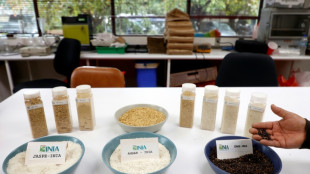

Americans seek cheaper dentistry in Mexico's 'Molar City'
Hundreds of thousands of Americans travel across the Mexican border every year to the tiny town of Los Algodones, in search not of sun and sand, but root canals and veneers.
Around 600 dentists cram the four main streets of the town, offering procedures at just a fraction of the cost in the United States.
"It's the highest concentration of dentists per square kilometer in the world," jokes one of the men jostling for customers near the border checkpoint.
Los Algodones is better known to Americans as "Molar City," a nickname that spread by word of mouth long before the internet made shopping around for healthcare easier.
The town long ago embraced the moniker, and now operates a website -- molarcity.org -- to help potential patients choose doctors and resolve travel logistics.
Competition is fierce, with colorful signs hanging off every balcony, flyers advertising discounts for whitening, extractions and implants.
Despite so many dentists, there is still plenty of demand to go around.
During its November to April high season, Molar City's 7,000 population almost doubles with day-tripping Americans.
Even in the sweltering summer months, around 2,000 people come daily from US border states like California, Arizona or New Mexico.
- The cost of a Tesla -
A look at any dentist's price list reveals just why the place is so popular.
"In California my dentist wanted to put the equivalent of a Tesla in my mouth," quips Rene, a 65-year-old from California whose first visit to Molar City is for four implants.
"He told me the whole procedure would come out to $57,000," laughs the Uber driver, covering his mouth with one hand.
Dr Carlos Rubio, who trained in both Mexico and the United States, says the huge price differential is what initially attracts customers.
The discount is such, the 63-year-old says, that it more than covers the additional cost of travelling, even if a patient has to make repeated trips for multiple appointments.
US dental care is often funded through private insurance policies attached to employment, usually with annual limits on coverage.
According to the University of Illinois Chicago, around a quarter of Americans have no dental coverage, while public programs like Medicaid do not routinely cover all forms of dental care.
David Barry, a retiree who has been getting his teeth looked after in Molar City for more than a decade, says many Americans simply cannot afford to see the dentist.
"Most people in the US don't have dental insurance, or their dental insurance doesn't cover very much -- like $1,000 a year for a crown or so," he says.
"For something major it's not that great, so when I first came, I needed quite a bit of work -- a few implants and crowns.
"In California they quoted me $35,000. I think I paid about $6,000 or $8,000 here."
The 64-year-old, who now lives in Arizona, says many people have a misperception that dentistry in Mexico is of a lower quality.
In fact, he says: "The equipment here is more advanced. In my dentists at home, they still use impressions -- here they do it all electronically."
- 'Anyone need a dentist?' -
On the US side of the border, a large parking lot begins to fill up early, with most visitors seemingly older than 50.
"Morning! Anyone need a good dentist today?" a young man asks people as soon as they get out of their cars.
Before reaching the border gates, they will hear the same question -- in English -- three more times.
After passing through the massive border wall, a sign past the checkpoint announces their arrival in Los Algodones, a town "Founded in 1894."
Ten steps later, a pharmacy, an optician and the start of the dental clinics, plus a swarm of people offering services.
A few restaurants and shops selling handicrafts and colorful souvenirs mark the only interruption to the sea of medical establishments.
Rubio, who when he started in 1985 had to wait four months to see his first patient, now sees between 30 and 35 people a day.
He says there has been no discernible drop off after the kidnapping and murder of several Americans in Matamoros, Mexico, just over the border from Brownsville, Texas.
That high-profile event in early March shed light on the large number of US citizens participating in so-called medical tourism.
No one AFP spoke to had any qualms about visiting
"It's something that some people comment on in the United States, but I tell them that Los Algodones feels safe," says David Barry.
Rubio agrees.
"In this community, we don't have that problem," he says.
"We live off tourism, and we try to take care of it."
M.Tran--RTC


